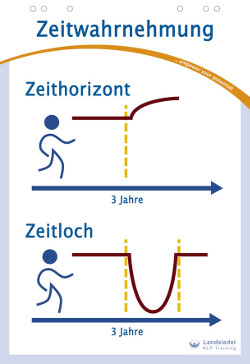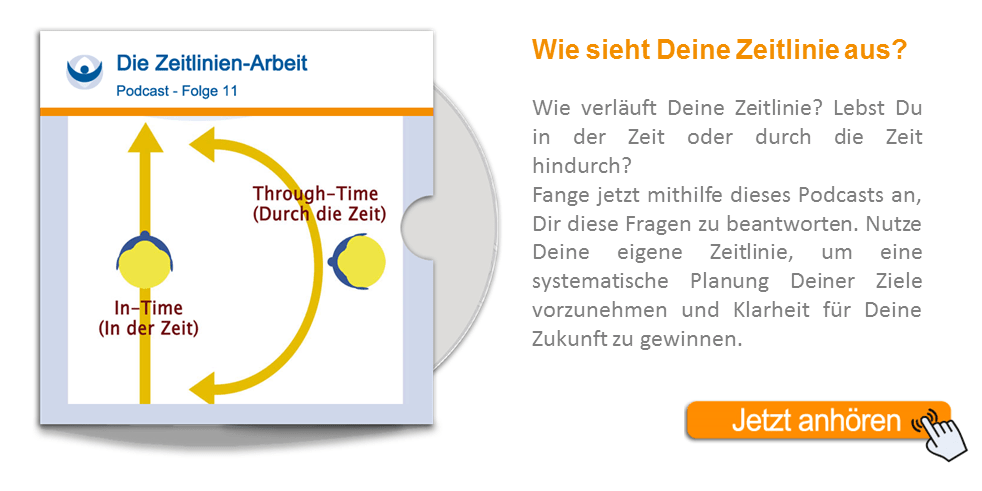Timeline Work
Use your timeline to systematically plan your goals and gain clarity by integrating your personal experiences from the past into your vision for the future. Develop an irresistible vision for your life.
Eliciting the Timeline
This section describes the basic idea of the timeline and how to discover it for later use in practical work.
Basic Idea:
How do we encode memories over time so that we can instantly tell which memory is earlier or later? How does our brain distinguish between past and future?
The basic hypothesis is that our brain spatially represents temporal differences. This has been empirically confirmed in many people.
Discovering the timeline enables us to make a large number of changes in a very short time.
Exercise:
Take an everyday action like making coffee, brushing your teeth, getting dressed, taking a shower, or something similar.
1. The Past
Remember (or pretend you can) when you
- made coffee this morning
- made coffee a week ago
- a year ago ...
- five years ago ...
- ten years ago ...
Now imagine you can perceive all these memories at once: how do you know that one memory is older than another?

Helpful Questions
Are these memories all in the same place or in different places, at different distances? Are they equally bright/colored, or different?
Is there something to hear? If so, is it equally loud or quiet, with the same sound quality?
Do you have the same feeling for all of them, or different ones, or none at all?
2. The Future
Now imagine (or pretend you can) how you will
- make coffee tomorrow
- make coffee in a week
- make coffee in a year
- in five years ...
- in ten years ...
Now imagine perceiving all these situations at once: how do you know that one situation lies further in the future than another?
3. The Entire Timeline
Now imagine perceiving both past and future at the same time:
How do you know which situation is past and which is future?
What is the key difference in the submodalities (VAKOG) of past and future?
4. Draw Your Timeline!
Different Types of Timelines
This section presents the two characteristic types of timelines:
The “In-Time” type and the “Through-Time” (or “Out-of-Time”) type, explained with their typical properties.
In-Time
The timeline runs through the point of the present (through the body).
- People live fully in the here and now (able to enjoy the moment without plans in mind).
- Punctuality is often not their strength, as they lack an overview of their timeline.
- Runs from back to front.
- Not everything is visible at once.
- Time feels flexible; schedules are less important.
- Memories are usually associated.
- It’s easy to focus on the present moment.
Through-Time
The timeline lies completely outside the person.
- Usually oriented from left to right.
- Past, present, and future are visible in front of the person.
- Provides a structured, organized view of life; schedules matter.
- Memories are normally dissociated.
- Harder to stay in the present moment.
- They value time highly and want to make the most of it.
Some people can easily switch modes – for example, being more In-Time while on vacation.
Spatial Configuration of the Timeline
Different spatial arrangements of timelines are possible and each has unique characteristics.
There are typical patterns such as time bulges or time horizons, which can reflect specific emotional experiences or traumas.

Time Horizon
With this type of timeline, the person cannot visualize any future beyond a certain horizon. This doesn’t necessarily mean their life is at risk, but it can happen. Example: A heart attack patient sees only a black hole three years ahead. For short horizons, this may indicate strong fear.
Time Gap
Here, the person finds it hard or impossible to imagine a certain period of time. You can make short-term plans with them, but long-term arrangements are difficult. For example, planning a meeting next week might be fine, but asking about a trip in a year could be met with uncertainty.
Time Bulge
This timeline came from a 40-year-old man who had gone through a divorce three years earlier, which still affected him deeply. He could talk normally about the past and even near-future plans. However, when asked about something three years ahead, he became depressed and hopeless. His emotional pain about the past distorted his view of the future.
Besides bulges and gaps, the "angle of inclination" of your timeline is important — whether it rises, falls, or remains horizontal.
Language Patterns
The types of timelines and how we represent time are reflected in our language. The words and expressions we use can reveal a lot about our inner timeline.
What difference do you notice in your reactions to the following phrases?
- Think of a time when you were hiking.
- Think of the last time you went hiking.
- Think of how you will be hiking soon.
- Think of a time when you will go hiking.
Now imagine yourself far in the future, recalling a past event that hasn’t actually happened yet:
Think of a moment when you will have gone hiking.
1. Therapist:
“So you were afraid? Is that what you felt?”
2. Therapist:
“So you are afraid? What keeps making you afraid?”
We constantly influence ourselves and others through such language patterns. Do we achieve what we want with them?
Common Expressions
- That’s behind me!
- That’s ahead of me!
- Time is slipping away.
- Looking back on something.
- There’s a lot coming my way.
- The past is catching up with me.
- I’ll let that slide.
- Time is on my side.
Removing Bulges and Gaps
This section describes how to clear timelines of gaps and bulges.
- Imagine your timeline as a clothesline with images hanging from it. Now picture someone pulling it tight so the bulges disappear.
- Imagine how you would like your timeline to look and ask someone to hold their hand where you want each image to be. Visualize each image in its new place.
Make your timeline aesthetic – straight or gently curved, without bulges or overlaps.
Design Criteria
- Past and future should be clearly distinct (e.g., front–back, left–right).
- If lines cross, it can cause confusion or stress.
- It’s unfavorable if timelines reverse, causing mix-ups.
The Submodalities of Time
Discover the unique characteristics of your timeline. For many, this is one of the most fascinating parts of their NLP training.
Enticing Future
The “Enticing Future” format is a technique that helps you plan and pre-program your desired future on your timeline.
Re-Imprinting According to Dilts
One of the most powerful NLP formats. It is particularly suitable for dealing with serious trauma and difficult early childhood experiences.
Read a blog post from Stephan Landsiedel’s Practitioner Training on the topic of Timeline.

 Deutsch
Deutsch English
English Français
Français 中文
中文 Español
Español नहीं
नहीं Русский
Русский